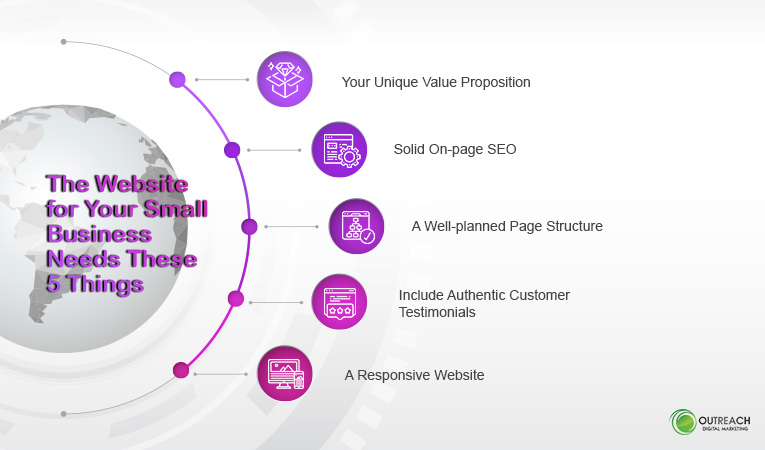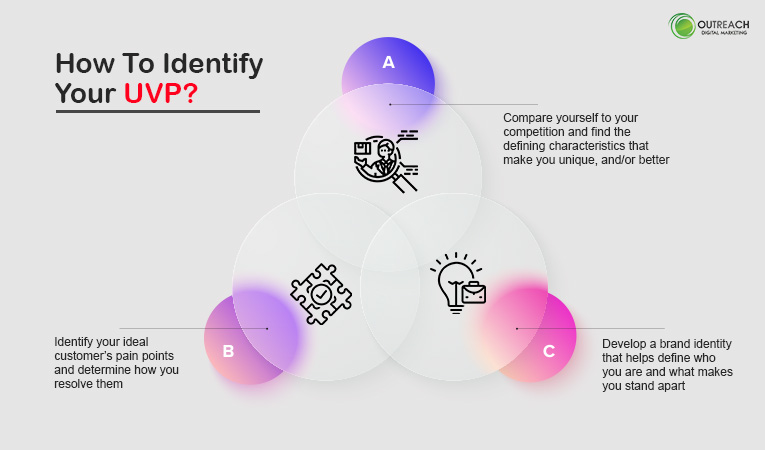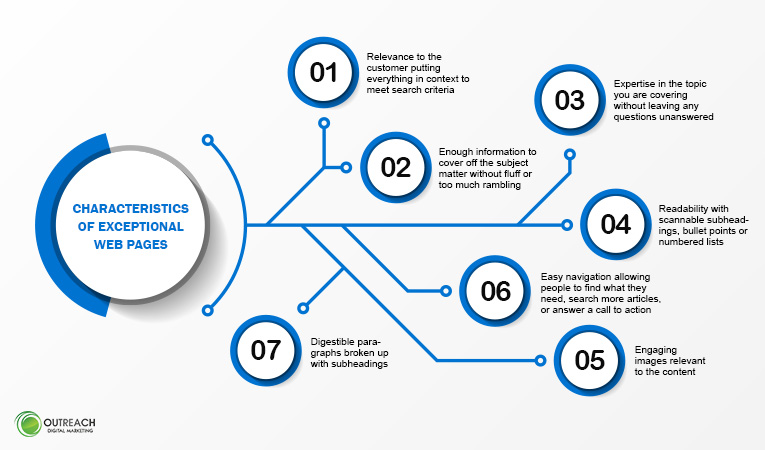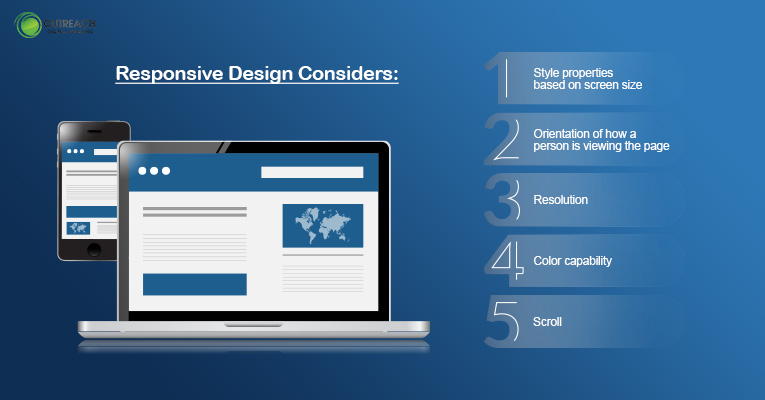From the moment you start up your small business, you need a website. While many small business owners turn to social media first, there is just no getting around the fact you need a website. No doubt social media is an excellent way to interact with customers, and grow brand awareness. However, it just doesn’t provide the detailed content about your product and services customers need to make a firm decision.
When considering your web design, there are five things every small business needs to include, whether you are an e-commerce site, offer professional services, or are supplementing your brick and mortar operations. Here are the elements you must include to grow your online presence and develop a sustainable customer base.

1. Your Unique Value Proposition
Look at similar businesses to yours and take note of the things that make you better. Your website isn’t about showing prospects the things you share in common with your competitors, but instead, the things you offer they do not. What makes you stand out? You want to clearly position yourself as a business that does something very different and very specific compared to competitors. Why would anyone wear your line of jeans? What makes your approach to interior design better suited to a certain type of person? How does your customer service make each customer’s experience pain free? How will you resolve issues?
In order to do this, you need to understand what your customers need and choose a target that can help create a niche. It might be that you’re an eco-friendly painting company, or that you focus on using sustainable materials. As a restaurant, you might focus on local ingredients, or bake all the bread for your sandwiches on site.
You might even have an interesting back story, such as you only hire veterans, or overcame a very moving life challenge to get where you are today. It is the little details that set you apart so you can attract a certain customer base, and provide something specific for their needs. You can identify your UVP using these tips:

- Compare yourself to your competition and find the defining characteristics that make you unique, and/or better
- Identify your ideal customer’s pain points and determine how you resolve them
- Develop a brand identity that helps define who you are and what makes you stand apart
With some time and patience, you can nail down your UVP to create a website designed to meet the needs of your ideal customer.
2. Solid On-page SEO
Online searches are the starting point for almost every consumer and business looking for a product or service. Research is easier than ever allowing people to learn everything they need to know about anything. As a result, your small business needs to have an SEO strategy.
SEO or search engine optimization is what allows prospects to find you. It all begins with keyword research to find the words, phrases, and voice search questions your customers use when searching for your particular products and services. Your keywords should appear throughout your website naturally, not awkwardly or forced into every single paragraph. Instead, you can use proven on-page SEO tactics to ensure the most important fields are used including:
- Title tags: This is the title given to your link appearing in the search results. Your title tags should be no more than 60 characters and include your target keyword. The more direct and to the point your title tags, the clearer content becomes. Title tags that tend to perform well have questions such as How to Create the Ideal Website, Where you Might be Going Wrong in Your SEO Strategy, or What Every Business Needs to Know About Sales Leads. You can also use words that entice such as best, top, leading, must. Avoid using duplicate titles and keep things simple.
- Page URL: Your URL should include your keyword and as much of your title as possible as another hint about your content for both search engines and users.
- Page headings: These are the headings appearing on each of your web pages. Optimizing them using keywords and H1 tags on every page of your website helps create solid on-page SEO. Make sure target keywords appear in the title naturally and use subheadings to provide an easy view of what your content is all about.
- The webpage copy: Each page of your website should have well-written, informative copy that is original, engaging and grammatically correct. Never take copy from other websites word for word, and always create original content with ideas that reflect your brand. Never place keywords in sentences if they don’t fit naturally or pack your pages with keywords for the sake of SEO. This actually works against you.
- The meta description: Meta descriptions are the sentence or two appearing under your title tags. They should be from 140 to up to 160 characters and include your target keyword. This is your chance to use a bit more description about the page’s content to help encourage more clicks.
- Image alt tags: Alt tags are like keywords for images helping to support SEO. You can also optimize images by compressing them and using JPEGs to ensure they load quickly.
Choosing a website platform that includes SEO support can help make all of these things easier to achieve.
3. A Well-planned Page Structure
When your pages are well-structured you create a website with purpose making it easy for visitors to find what they need. Each page should meet a specific need and provide a call to action to help people understand their next step. As well, each service you have should have its own page with its own call to action.
If you have specific service areas, adding a service page for each service and each area using geo keywords really improves your local SEO. With proper structure, pages with purpose and clear calls to action you can meet your goals and help visitors meet theirs. Exceptional web pages share these characteristics:

- Relevance to the customer putting everything in context to meet search criteria
- Enough information to cover off the subject matter without fluff or too much rambling
- Expertise in the topic you are covering without leaving any questions unanswered
- Readability with scannable subheadings, bullet points or numbered lists
- Digestible paragraphs broken up with subheadings
- Engaging images relevant to the content
- Easy navigation allowing people to find what they need, search more articles, or answer a call to action
Paying attention to these details will help you create high-quality content for blog pages, service pages, and landing pages.
4. Include Authentic Customer Testimonials
All the bragging in the world won’t be as effective as authentic customer testimonials. Today final decisions are influenced by online reviews, comments, and ratings. Nothing is easier to help ease prospects over the finish line than providing real-life testimonials about how your products and services helped other customers.
Your customers are your most precious asset not just for generating revenue, but also for building your customer base. Instead of depending on you to tell them what you offer, they hear from people with the same problems and needs as their own. Your testimonials should appear throughout your website so that no matter where someone visits, they will see what your customers have to say about you. The more relevant the testimonial is to the content on that page, the more influence it will have on the prospect’s decisions.
Don’t be afraid to ask customers for testimonials. An easy way to do this is to use a drip email campaign with automatic emails sent out through each step of the customer journey. Once a purchase has been made, the email is sent out with a link asking for a review or testimonial.
5. A Responsive Website
You just need to consider your own habits to understand how most people will find your website. In the first quarter of 2021, mobile devices accounted for 54.8% of website traffic around the world. This does not include tablets. A responsive website is mobile-friendly and detects the type of device a person is using. Your pages then accommodate that device with a responsive design that is easy to use, view your pages, navigate and scroll to find information. The more intuitive your design, the more people enjoy their user experience. Google scans your site to make sure it is mobile optimized and always gives preference to responsive designs.
Let’s go through some helpful stats data from Rebrandly on importance of having a responsive website:
- There’s more mobile internet traffic than desktop/PC traffic.
- People will like your website better if it offers a good mobile experience
- People won’t recommend you to their friends if your website’s mobile UX is poor.
- Not having a mobile-friendly website helps your competitors.
- A poor mobile experience can hurt your company’s reputation.
- A mobile-optimized website increases consumer trust and positive feedback.
Responsive design considers:

- Style properties based on screen size
- Orientation of how a person is viewing the page
- Resolution
- Color capability
- Scroll
All of these style properties instantly accommodate the device. Users won’t hang around very long if your website is slow to load, difficult to read, and lacks the content they need.
Using these five things for your web design will provide the ultimate base for your digital marketing plan.
Do you need help creating a website that will turn prospects into paying customers? Let’s get started today.
